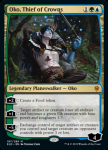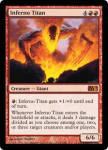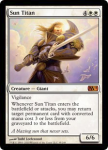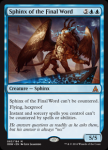There's a known trend in Vintage for most of the 2010's, in which Oath decks took up a small share of the metagame most of the time, but were usually more prolific in major tournaments. It became an expected factor in Vintage tournament analysis and discussion, as savvy players came to anticipate spikes in the representation of Oath in big tournaments. And despite minor changes here and there, Oath held up pretty consistently in this role. More recently, there have been two major changes.
- The advent of new and superior planeswalkers in 2019.
- The printing of Underworld Breach in 2020.
The first of those changes isn't really too much of a departure from what Oath decks were already doing. Dack Fayden remained a premier planeswalker for the archetype, but was joined by some new friends.



For the most part, these new options just made planeswalker-based control more effective, and the improvement to Oath as a gameplan was indirect. The notable exception would be the potential for Oko to turn an opponent's artifact into an elk, exposing the opponent to Oath of Druids even Forbidden Orchard has been kept off the battlefield.
Underworld Breach changed everything, and most Vintage Oath decks since February of 2020 have been Underworld Breach decks. The big card dump from library to graveyard that Oath provides has been perceived in different ways over the years, with some Oath decks built to exploit it (such as Bomberman) and other decks built to cancel it out (such as Gaea's Blessing variants). Underworld Breach takes this to an extreme, and has catapulted Sun Titan into a position as one of the best creatures to run in an Oath deck.

The card was banned in Legacy, but remains legal in Vintage, and has proven itself as a powerhouse. Not all Breach decks are Oath decks, but almost all Oath decks have evolved into Breach decks. Perhaps some new development will supersede this. It wouldn't be the first time: Oath decks have been a fixture in Vintage since 2004 and the only really consistent features have been Forbidden Orchard and countermagic. Nothing is sacred, and the Philosophy of Fire has shown tendency for new cards to shake everything up, sometimes even rendering slightly-less-new cards obsolete. But the combination of Oath of Druids and Underworld Breach displays a potency that stands out even by today's standards, and if I had to guess, I'd say that it's sticking around for a long time.
Oath of Druids in EDH
Well, that about covers it. While far from exhaustive, I've covered more history of Vintage Oath decks than I'd have expected to see at the CPA. The card is fascinating, but time has had an awkward effect: the old context in which I saw Oath of Druids as a casual player and in which tournament players used it in mainstream formats might as well be ancient history. The card left the now-dead format of Extended a long time ago and has never been legal in Legacy or Modern. Oath became famous in the Extended format, but almost all of its documented history has been as a Vintage card. Longtime Magic fans who remember the card would remember it for stuff like Morphling and Spike Weaver loops, but to be entirely fair, that stuff is basically prehistory, and the card has spent almost its whole lifetime as a Vintage-exclusive.
I'd be remiss if I didn't at least touch on Magic's most popular format. Oath of Druids has always been legal in EDH, and even got a reprint in the
Commander 2016 product, appearing in the "Stalwart Unity" precon. This deck even has Forbidden Orchard!
Commander:
1 Kynaios and Tiro of Meletis
1 Veteran Explorer
1 Humble Defector
1 Hushwing Gryff
1 Chasm Skulker
1 Gwafa Hazid, Profiteer
1 Selvala, Explorer Returned
1 Edric, Spymaster of Trest
1 Akroan Horse
1 Windborn Muse
1 Horizon Chimera
1 Zedruu the Greathearted
1 Psychosis Crawler
1 Kazuul, Tyrant of the Cliffs
1 Realm Seekers
1 Rubblehulk
1 Progenitor Mimic
1 Blazing Archon
1 Orzhov Advokist
1 Ludevic, Necro-Alchemist
1 Selfless Squire
1 Sidar Kondo of Jamuraa
1 Kraum, Ludevic's Opus
1 Minds Aglow
1 Collective Voyage
1 Cultivate
1 Kodama's Reach
1 Tempt with Discovery
1 Wave of Reckoning
1 Reverse the Sands
1 Blasphemous Act
1 Migratory Route
1 Seeds of Renewal
1 Treacherous Terrain
1 Swords to Plowshares
1 Swan Song
1 Arcane Denial
1 Oblation
1 Beast Within
1 Reins of Power
1 Benefactor's Draught
1 Entrapment Maneuver
1 Sylvan Reclamation
1 Sol Ring
1 Empyrial Plate
1 Howling Mine
1 Commander's Sphere
1 Temple Bell
1 Assault Suit
1 Venser's Journal
1 Keening Stone
1 Prismatic Geoscope
1 Oath of Druids
1 Ghostly Prison
1 Propaganda
1 Rites of Flourishing
1 Sphere of Safety
1 Lurking Predators
1 Hoofprints of the Stag
1 Evolutionary Escalation
1 Azorius Chancery
1 Command Tower
1 Evolving Wilds
1 Exotic Orchard
1 Forbidden Orchard
1 Frontier Bivouac
1 Gruul Turf
1 Homeward Path
1 Izzet Boilerworks
1 Jungle Shrine
1 Krosan Verge
1 Myriad Landscape
1 Mystic Monastery
1 Opal Palace
1 Rupture Spire
1 Seaside Citadel
1 Selesnya Sanctuary
1 Terramorphic Expanse
1 Transguild Promenade
5 Plains
5 Island
5 Mountain
5 Forest
1 Ash Barrens
It's not really an Oath deck, but it does offer players the tools they might want to build one. The actual use of Oath here is a bit limited and, at the wrong table, dangerous. So I think it was probably a bit forced. I mean, it kind of works? I don't know. If I'm being really cynical, WotC wanted to run Forbidden Orchard in this deck because it would add financial "value" by reprinting a moderately expensive card, and made sense in the context of what this deck does. Oath of Druids would have been thrown in because Forbidden Orchard was already going in the deck anyway. I mean, I'm glad they did it, but it is a bit awkward.
Oath of Druids has never been particularly popular in EDH. The precon might have helped, but EDHrec shows the card as appearing in 1,051 decklists in the past two years. Based on the presence of some real nonbos on the card's page, I'd guess that between 20% and 30% of the Oath-containing decks on EDHrec are actually just modified versions of "Stalwart Unity."
I find Oath a bit underutilized in EDH, but I've been no help myself: I've never used the card in my own EDH decks. I have plans to remedy that, but no decklist at this time. Some day, though...


















